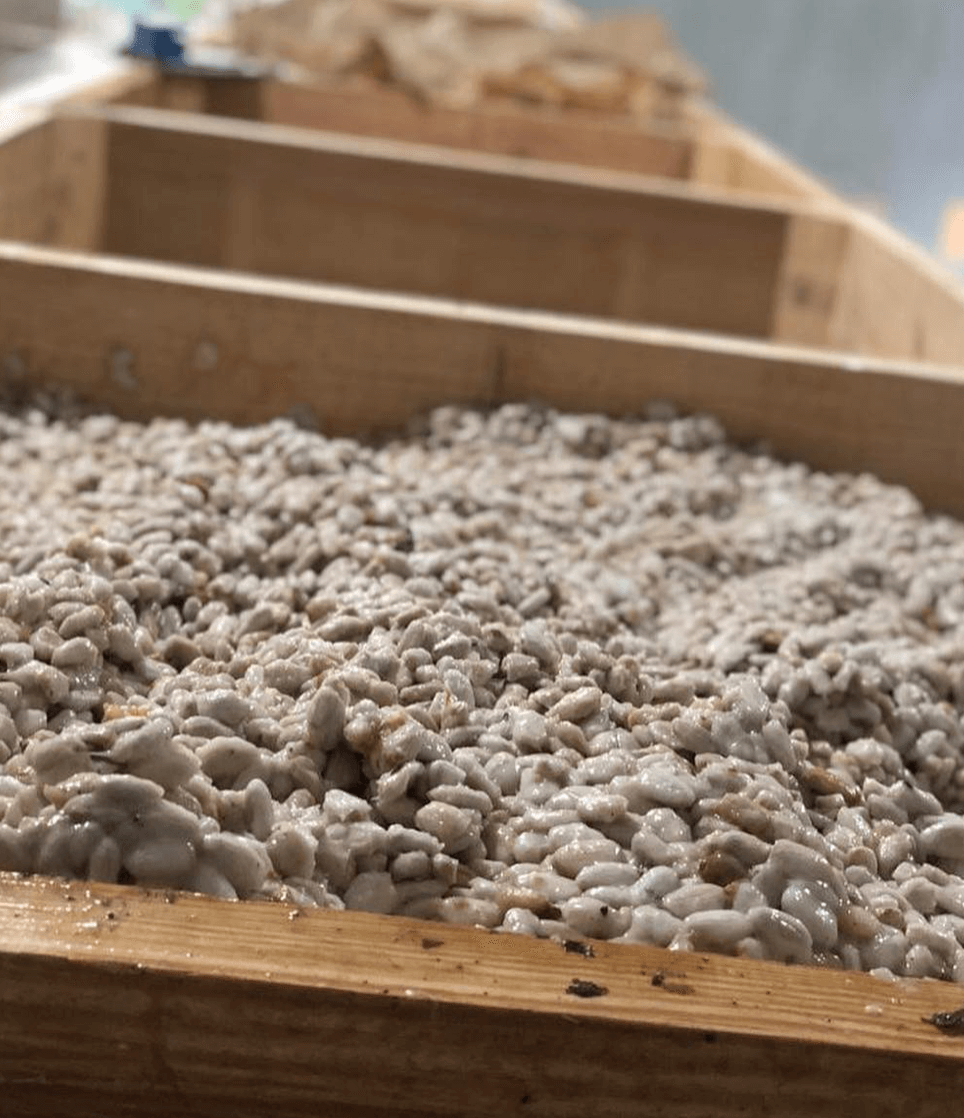
The Cacao Co-Op
With 90% of cacao beans coming from small family farms, co-operatives are a common central repository that provide a shared way to shoulder the costs associated with Bean preparation.
Wet Beans
Upon harvest, the cacao tree yields seeds (commonly referred to as beans) enveloped in a sweet, white, gelatinous pulp, all housed within the cacao pod. Farmers collect these wet beans and transport them to cooperatives for the crucial initial stages of processing, which include:
Fermentation: This critical step develops the beans' flavor.
Drying: Beans are dried to reduce moisture content, stabilizing them for storage.
Cleaning: Any debris or imperfect beans are removed.
Bagging: Clean, dried beans are bagged for transport or sale.
History Lesson: The surrounding sugary pulp is not just discarded; historically, it was consumed as a delicacy and even fermented into alcohol, one of its earliest known uses.
The value initially placed on cacao seeds is subject to much speculation. The prevailing theory suggests that they were initially overlooked, often discarded after the consumption of the fruit's pulp. It's tempting to imagine that the accidental roasting of these discarded seeds on a fire might have unveiled the enticing aroma of what we now associate with brownies, captivating the senses of those early discoverers.
Fermentation
With hundreds of time-honored techniques available, fermenting wet cacao is arguably the most pivotal step in crafting the bean's flavor profile.
This crucial phase in flavor enhancement underscores the value of a cooperative (co-op) as a collective asset. The co-op's infrastructure, advanced technology, and educational resources serve a wide community of farming families, elevating the quality of their produce.
Note: Industrial buyers often prioritize compliance with health standards over the nuanced artistry required to optimize flavor during fermentation. This approach may lead to compromises in the fermentation process, seen as "shortcuts" or indicators of "poor quality" by those of us in the artisan bean-to-bar sector. For artisan chocolatiers, the meticulous care and attention to detail in fermentation are non-negotiable, directly influencing the distinction and appeal of the final product.
During the initial anaerobic phase of fermentation, natural yeasts consume the sugars within the cacao pulp, producing bacteria, acids, ethyl alcohol, and heat. This generated heat eventually halts the yeast activity.
In the subsequent aerobic phase, the beans begin to change color and develop their distinct flavor profiles. Fermentation typically spans 4 to 8 days, with temperatures sometimes exceeding 130°F (54°C).
Note on "Raw" Cocoa: The term "raw cocoa" commonly refers to cacao beans that have been fermented and dried. However, the designation "raw," especially regarding health benefits, usually implies that food temperatures have not exceeded 115°F (46°C)—a threshold fermented cacao cannot meet due to the heat produced during fermentation. Therefore, when we refer to cacao as "raw" within this industry context, we align with the conventional usage rather than suggesting adherence to strict raw food criteria. It's important to note that unfermented cacao beans may pose health risks and necessitate thorough, immediate processing to ensure safety for consumption.
The beans will change from purple to dark brown and become less astringent during the fermentation process.
Drying
Drying fermented cacao beans is a crucial step, with methods varying significantly depending on the local climate. A straightforward technique involves spreading the beans on tarps directly on the ground. However, a more prevalent practice is to use raised platforms equipped with a porous base to enhance airflow around the beans.
For optimal drying, it's essential to lay the beans in a thin layer and turn them regularly, ensuring they dry evenly and thoroughly. Neglecting this step can result in mold growth and the development of undesirable flavors, potentially compromising an entire crop.
The drying process is complete once the beans achieve a moisture content of 7-8%, making them ready for the next stages in cocoa production.
These beds, drying in the sun, are on rollers allowing them to be pushed under a protective canopy in the case of rain.
Bagging & Export
After the cacao beans have been properly dried—and cleaned to remove any debris or defective beans—they are ready to be bagged and sold to exporters. This cleaning step varies dramatically around the world which is why we also incorporate a cleaning process once the beans get to us.
Cooperatives (Co-Ops) typically apply a 50% premium on the price paid to the farmer. This markup covers operational costs and contributes to the collective well-being of the community. Operations demanding more labor, higher-end equipment, or specialized processes may incur additional charges for their services.
Note on Terminology: The word “cacao” is derived from Spanish for “cocoa” and can be used interchangeably in English. Some will differentiate between the two by suggesting "cacao" refers to beans that are unprocessed, while "cocoa" implies that the beans have been fermented and dried. Without guidelines or a strict definition, we prefer “cacao” as it communicates our commitment to minimal processing and to honor the deep connections we have with our sources. This choice underscores our dedication to offering chocolate that's as close to its natural state as possible, celebrating the bean's intrinsic qualities. This tends to be a typical nomenclature used with artisans of this craft.







